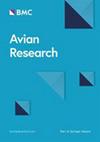Nestlings of two parrotbill species can independently evaluate the presence of predators based on acoustic cues
IF 1.7
2区 生物学
Q1 ORNITHOLOGY
引用次数: 0
Abstract
Nest predation is the leading cause of reproductive failure in birds and a major driving force in the evolution of anti-predation strategies. Current studies on the anti-predation strategies of birds driven by predation pressure have mainly focused on adults. However, the detection and behavioral responses of nestlings toward predation risk require further investigation. In this study, we examined nestling responses to predator sounds. Two species of nestlings, the Reed Parrotbill (Paradoxornis heudei) and Vinous-throated Parrotbill (Sinosuthora webbiana), were exposed to the Sparrowhawk (Accipiter nisus, less common) and Oriental Magpie (Pica serica, more common), which are predator species, the Oriental Turtle Dove (Streptopelia orientalis), which is a commonly found harmless species, and background noise. Our findings revealed that compared to pre-playback of natural begging and playback of background noise and Oriental Turtle Dove sounds, playback of the two predator types decreased the total begging time and total number of calls of the two nestlings species, with the calls of the Sparrowhawk leading to greater suppression of nestling begging behavior than those of the Oriental Magpie. Therefore, our results indicated that these nestlings were able to distinguish predators from harmless species based on auditory cues.
两种鹦鹉的雏鸟可以根据声音线索独立评估捕食者的存在
巢捕食是鸟类繁殖失败的主要原因,也是反捕食策略进化的主要驱动力。目前对捕食压力驱动下鸟类反捕食策略的研究主要集中在成鸟身上。然而,雏鸟对捕食风险的探测和行为反应需要进一步的研究。在这项研究中,我们研究了雏鸟对捕食者声音的反应。雀鹰(Accipiter nisus,不常见)和东方喜鹊(Pica serica,更常见)是捕食者,东方斑鸠(Streptopelia orientalis,常见的无害物种)是一种背景噪音,两种雏鸟,芦苇鹦鹉(Paradoxornis heudei)和蛇喉鹦鹉(Sinosuthora webbiana)暴露于此。结果表明,与自然乞讨的预播放、背景噪音和东方斑鸠的声音播放相比,两种捕食者类型的播放减少了两种雏鸟的总乞讨时间和总叫声次数,其中雀鹰的叫声比东方鹊的叫声更能抑制雏鸟的乞讨行为。因此,我们的研究结果表明,这些雏鸟能够根据听觉线索区分捕食者和无害物种。
本文章由计算机程序翻译,如有差异,请以英文原文为准。
求助全文
约1分钟内获得全文
求助全文
来源期刊

Avian Research
ORNITHOLOGY-
CiteScore
2.90
自引率
16.70%
发文量
456
审稿时长
46 days
期刊介绍:
Avian Research is an open access, peer-reviewed journal publishing high quality research and review articles on all aspects of ornithology from all over the world. It aims to report the latest and most significant progress in ornithology and to encourage exchange of ideas among international ornithologists. As an open access journal, Avian Research provides a unique opportunity to publish high quality contents that will be internationally accessible to any reader at no cost.
 求助内容:
求助内容: 应助结果提醒方式:
应助结果提醒方式:


